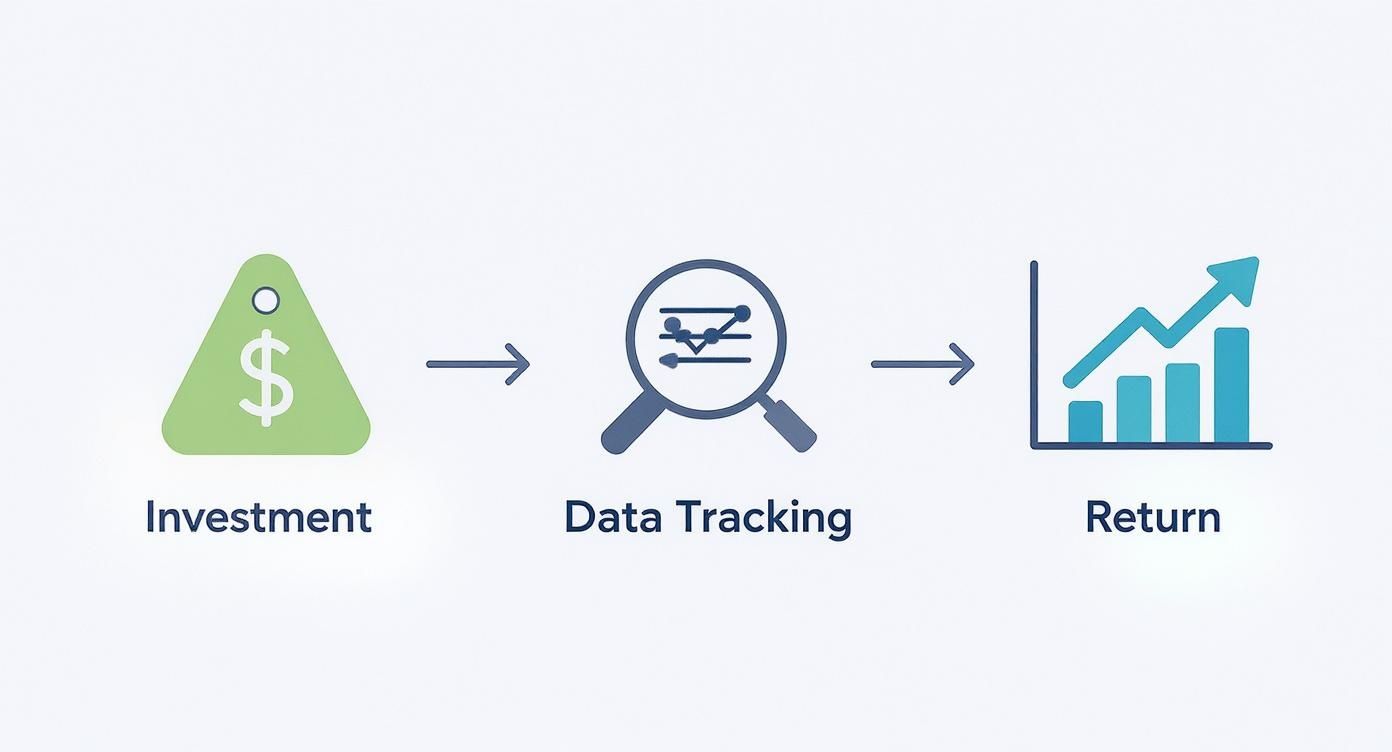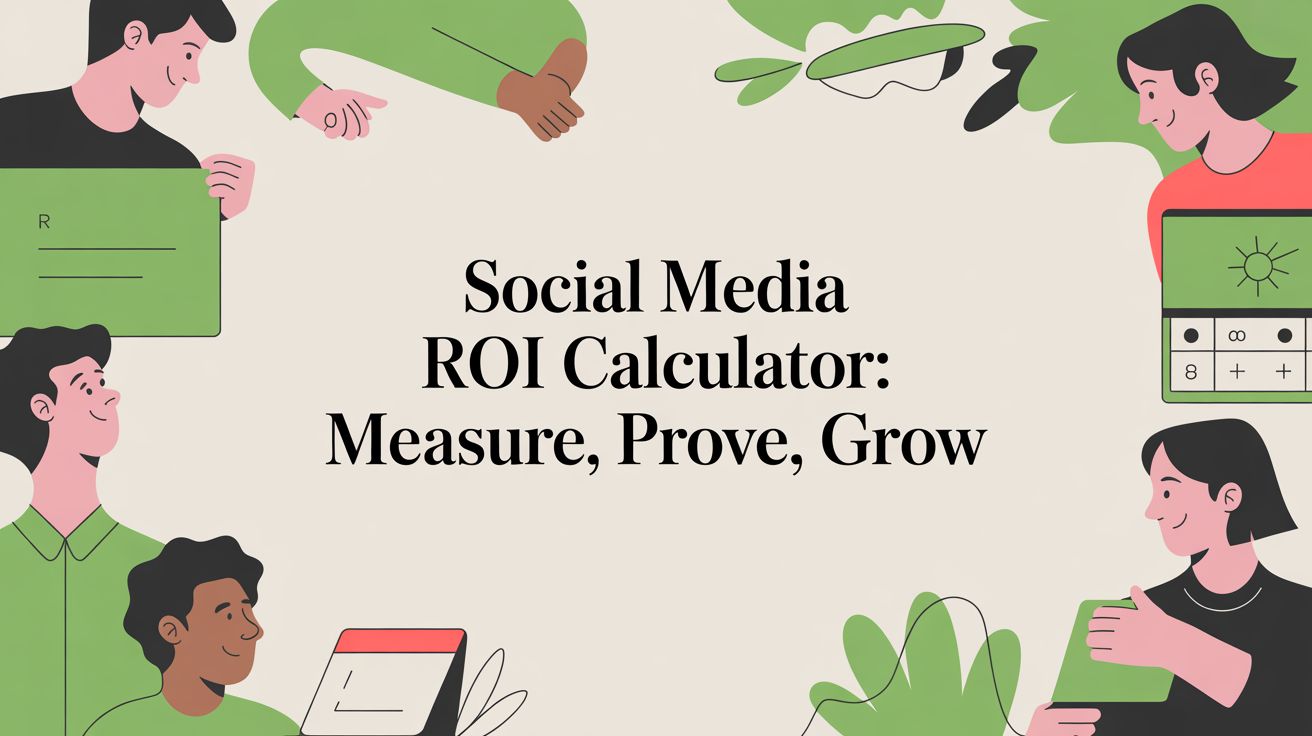Are you struggling to prove that your social media efforts are actually making money? A social media ROI calculator is the key. It’s a straightforward way to measure the profitability of your campaigns by comparing the revenue you’ve earned (the return) against the money, time, and resources you’ve invested.
This isn’t about chasing likes or shares. It’s about getting a data-backed answer to one critical question: Is your social media a money pit or a money-maker? It’s the tool that finally connects your hard work to the bottom line, giving you the proof you need to justify your budget and grow your strategy.
Why Your Social Media Needs a Reality Check

Does this sound familiar? You walk into a meeting armed with impressive engagement reports—likes are up, shares are through the roof, follower counts are climbing. But then your boss hits you with the one question that matters: “But what does this actually mean for our sales?”
If you’ve felt that sinking feeling, you’re not alone. So many marketers struggle to justify their social media spend because they can’t connect the dots between their daily activity and the company’s bottom line. This is the exact problem a social media ROI calculator solves. It’s no longer a nice-to-have; it’s essential for survival.
Making the switch from chasing vanity metrics to tracking real ROI is a game-changer. It’s the difference between hoping your strategy is working and knowing exactly how it fuels business growth.
Moving Beyond Vanity Metrics
Likes and shares feel great, but they don’t keep the lights on. A solid social media ROI calculation is the hard proof you need to get buy-in from leadership and secure the budget you deserve.
Think about it. Instead of saying, “Our latest post got 500 likes,” you can confidently state, “Our recent campaign generated a 150% return on investment.” That kind of language completely changes the conversation from social chatter to real business impact.
When you can prove your value with hard numbers, you unlock the ability to:
- Make Smarter Decisions: Are you tired of guessing which platforms work? You’ll know exactly which ones are driving revenue, so you can double down with confidence.
- Optimize for Profit: Spot underperforming campaigns early on and pivot your strategy before you waste another dollar.
- Secure Bigger Budgets: Nothing justifies a request for more resources like data-backed evidence of profitability.
The real challenge for most marketers isn’t a lack of effort. It’s the disconnect between that effort and tangible business outcomes. A clear ROI calculation is the bridge that turns your social media presence from a line-item expense into a measurable, high-performing asset.
The Role of High-Quality Content in ROI
Of course, the “Return” part of your ROI equation hinges entirely on how effective your content is. You could have the most sophisticated tracking system in the world, but if your posts aren’t compelling people to act, your ROI will always be disappointing.
This is where a lot of teams get stuck. Are you spending countless hours brainstorming, writing, and designing content, all for unpredictable results? That manual grind is a massive, hidden cost that drags your ROI down.
That’s the exact problem we built EchoWriteAI to solve. Our AI platform is designed to dramatically improve your returns by generating high-converting social media content directly from your existing long-form assets, like blog posts or webinars. Instead of starting from scratch, you get dozens of platform-specific posts that are already on-brand and fine-tuned to drive clicks and conversions. This directly pumps up the revenue side of your ROI calculation while slashing the time and costs you sink into content creation. It’s a win-win.
Nailing Down the Numbers: Gathering the Right Data for Your ROI Calculator
Any social media ROI calculator is only as good as the numbers you feed it. Let’s be blunt: “garbage in, garbage out” is the absolute truth here. If you want a figure that means something in the boardroom, you have to look past the vanity metrics and get serious about tracking the real inputs.
This all boils down to two sides of the same coin: Investment and Return. One is everything you spend—time, money, resources. The other is every dollar that comes back to the business as a result. Getting an accurate picture means you have to be meticulous about both.
What Are You Really Spending on Social Media?
This is where most marketers trip up. They think their “investment” is just their ad budget. That’s a huge mistake, and it leads to wildly inflated ROI figures that create a false sense of security. The truth is, your real investment includes every single resource you pour into your social strategy.
You’ve got to think bigger. Your total investment is a mix of a few critical costs:
- Ad Spend: This is the easy one—the money you’re giving directly to platforms like LinkedIn, Facebook, or Instagram to run your campaigns.
- Tools and Software: Don’t forget the monthly or annual fees for your scheduling tools, analytics dashboards, and any content creation software. It all adds up.
- Content Creation Costs: Think about expenses for graphic design, video production, or payments to freelance writers and creators.
- Team Hours: This is the big one people miss. The time your team dedicates to planning, creating, managing, and engaging on social media is a major cost. Our guide on social media manager costs can help you put a real number on this.
This is exactly where a tool like EchoWriteAI can be a game-changer for your ROI. It automates the creation of dozens of social posts from one core piece of content. That directly slashes the team hours and content creation costs that eat into your budget, making your entire social media engine leaner and more profitable.
Tracking the Returns That Actually Move the Needle
Now for the other side of the equation: your ‘Return’. This needs to be tracked with the same level of detail. This is how you draw a straight line from a Tweet or a TikTok video to a real business result. Likes and shares are nice, but they don’t keep the lights on.
The ground has really shifted under our feet. Heading into 2025, tracking social media ROI isn’t just a “nice-to-have” anymore; algorithm shifts and privacy changes have made it a necessity. In fact, a whopping 67% of marketers now say that attributing revenue from social media is their number one measurement goal. That’s a massive change from the old days of just chasing engagement. You can dig deeper into current social media cost strategies on quimbydigital.com.
To do this right, you need to zero in on these metrics:
- Direct Revenue from Conversions: Sales coming from unique links or promo codes you shared on social.
- Lead Value: What’s a qualified lead from social media worth to your sales team? Put a dollar figure on it.
- Customer Lifetime Value (CLV): For customers you brought in through social, what’s their total value over time?
- Cost Savings: Did your social customer support team handle issues that would have otherwise clogged up your call center? That’s a real, tangible return.
To give you a clearer picture, here’s a breakdown of the essential metrics you’ll need to pull together.
Essential Metrics for Your ROI Calculation
This table outlines the crucial investment costs and return metrics you must track for a reliable ROI calculation.
| Metric Category | Specific Metrics to Track | Where to Find This Data |
|---|---|---|
| INVESTMENT (COSTS) | Ad spend, tool subscriptions, content creation expenses (freelancers, software), team salaries/hours. | Ad platform dashboards (Meta Ads Manager, LinkedIn Campaign Manager), accounting software, project management tools. |
| RETURN (REVENUE) | Revenue from conversions, Lead Value, Customer Lifetime Value (CLV), cost savings (e.g., in customer support). | Google Analytics 4, CRM platform (like Salesforce or HubSpot), e-commerce platform analytics (Shopify). |
Getting these numbers right is the foundation of a meaningful ROI. It’s not just about plugging figures into a spreadsheet; it’s about understanding the true financial story of your social media efforts.
The secret is to build solid tracking into your process from day one. Using UTM parameters on every link, setting up conversion goals in Google Analytics, and making sure your CRM is properly integrated aren’t just best practices—they’re the fundamental plumbing required to prove your social media program is worth the investment.
Putting the Social Media ROI Formula Into Action
Alright, let’s get down to brass tacks. Theory is great, but what really matters is watching your hard work and raw data turn into a powerful percentage that you can take to your boss. The classic formula—[(Return - Investment) / Investment] * 100—is your best friend here, and I promise it’s not as scary as it sounds.
Think of it as the bridge connecting what you spend on social media to the real-world value it creates. It’s how you tell a compelling story of success, backed by cold, hard numbers.

This simple flow really nails it: your initial investment, when you track it properly, feeds directly into the returns that prove your campaign was a winner.
A Real-World Campaign Example
Let’s walk through a scenario I see all the time. Imagine you’ve just launched a campaign to promote a brand-new service. You’ve been diligent about tracking every dollar in and every dollar out.
Your total investment shakes out to $6,500. Now, that’s not just your ad spend. It’s the whole picture. It includes $1,500 in fixed costs (think content creation, your social media tools, maybe a freelance designer) plus the $5,000 you spent on ads, which got you 2,000 engagements at $2.50 a pop.
On the other side of the equation, your tracking shows that $10,000 in new sign-ups for the service came directly from this campaign. Boom. You now have the two key figures for your social media ROI calculator.
Let’s plug them into the formula:
[(10,000 - 6,500) / 6,500] * 100
Run the numbers, and you get a final ROI of 53.85%. This is a fantastic result. It’s tangible proof that for every single dollar you put into this campaign, you got it back and made an extra 54 cents in profit. That’s a story worth telling. If you want to dig deeper into how top marketers frame these results, check out these insights on demand generation from thecmo.com.
The Takeaway: Your social media ROI isn’t just another metric. It’s the ultimate proof of your strategy’s financial impact. It transforms your role from just a “content person” to a genuine revenue driver for the business.
The Problem of Manual Effort
Calculating this for one campaign is one thing. But what about when you’re juggling five campaigns across three different platforms? Suddenly, the manual grind of creating unique, high-quality content for every single channel becomes a massive time and money sink. This is a huge, often overlooked cost that eats into your “Investment” total, shrinking your potential ROI before you even get off the ground.
This is exactly where EchoWriteAI solves your biggest problem. Instead of your team spending countless hours brainstorming and writing post after post, our AI can automate the creation of dozens of platform-specific variations from a single piece of your existing content. This slashes your content creation costs, which is one of the fastest and easiest ways to boost your ROI.
For leaner teams, embracing small business marketing automation isn’t just a nice-to-have; it’s how you scale your efforts without ballooning your costs. By optimizing the “Investment” part of the equation, EchoWriteAI helps ensure the numbers in your social media ROI calculator tell a much more profitable story.
Making Sense of Your ROI and Setting Smarter Benchmarks
Okay, you’ve plugged everything into your ROI calculator and now you have a number. A 50% ROI. Great, right? Maybe. But on its own, that percentage is just data floating in a spreadsheet. It doesn’t tell you the whole story.
The real magic happens when you start asking the right questions. Is this a good result for us? Are we crushing it compared to our competitors? Which of our channels is secretly a profit-printing machine? This is where you graduate from simply calculating to thinking like a strategist. It’s how you turn raw data into a roadmap for your next winning campaign.
How Do You Stack Up? Using Industry Benchmarks
One of the quickest ways to give your ROI context is to see how it compares to others in your field. A 50% ROI might be just average for an e-commerce brand, but for a B2B software company with a six-month sales cycle, it could be absolutely phenomenal. Understanding what’s typical for your niche helps you set goals that are ambitious but achievable.
Looking at industry benchmarks for 2025, it’s clear social media marketing—especially paid ads—is a powerful driver. Top-tier brands often see a return on ad spend (ROAS) between 3x and 5x. For every dollar they put in, they get three to five dollars back. On the lead generation side, the average cost per lead (CPL) from paid social ads is about $65. You can find more of these data-backed insights on marketing ROI calculators from AgencyAnalytics.
Benchmarks aren’t a finish line you have to cross. Think of them as a compass. If your CPL is double the industry average, that’s not a failure—it’s a bright, flashing sign showing you exactly where to start optimizing.
Pinpointing Your Most Profitable Channels
Your overall ROI is a great health check, but the real treasure is buried in the details. When you slice and dice your ROI by platform, you might uncover some serious surprises. Maybe you’ll find your LinkedIn campaigns are pulling in a massive 120% ROI, while your Instagram efforts are barely breaking even.
This is the kind of insight that changes everything. It tells you exactly where to double down with your budget and where you might need to completely rethink your game plan. Perhaps your audience on one platform devours video content, while another engages more with deep-dive articles.
Calculating ROI for each channel is fundamental to building a smart small business social media strategy that puts your money where it will work the hardest. This is also where EchoWriteAI becomes your secret weapon. Once you’ve identified a high-performing channel, you can instantly generate a steady stream of on-brand, high-converting content tailored for that specific platform, ensuring your best channels are always firing on all cylinders.
So, you’ve run the numbers and calculated your social media ROI. That’s a huge first step. It gives you a clear, no-fluff baseline of what’s working and what’s not. But here’s the thing: knowing your ROI is just the start. The real magic happens when you start to actively improve it. This is where you flip the switch from being reactive to proactive, and it’s where a tool like EchoWriteAI can give you a serious edge.
Too many marketers I know are stuck on a hamster wheel. They pour hours into creating content by hand, only to get lackluster results that barely nudge their ROI. That time and effort? It’s a huge hidden cost that silently kills your profitability.
EchoWriteAI zeroes in on the two things that matter most in your ROI formula: your Investment (the costs) and your Return (the results).

Slash Your Investment by Automating the Grind
Let’s talk about the “Investment” part of the equation. It’s easy to think of this as just your ad spend, but the real budget killer is often the man-hours. Every minute your team spends brainstorming, writing, rewriting, and scheduling posts is a direct hit to your bottom line. It’s a massive cost that limits how much you can actually do.
What if you could get that time back?
EchoWriteAI automates the most soul-crushing parts of creating content. Instead of a team member spending half a day wrestling with a single post, our AI can pull dozens of high-quality, ready-to-go content variations from a single blog or video. And it does it in minutes.
This isn’t just a small time-saver; it’s a strategic shift. Suddenly you can:
- Drastically cut down on team hours spent on social media grunt work.
- Reduce or even eliminate the need for freelance writers or designers for day-to-day posts.
- Free up budget to spend on things that actually drive revenue, not just fill a content calendar.
The point isn’t just to make more stuff. It’s to spend far less time and money on the manual labor of content creation. By shrinking the “Investment” number in your ROI calculation, you immediately boost your overall profitability.
Boost Your Return with Content That Actually Works
Now for the other side of the coin: the “Return.” A lower investment is a great start, but it means nothing if the content you’re putting out there doesn’t get people to act. Inconsistent messaging and pure guesswork are the biggest enemies of a high ROI.
This is exactly what EchoWriteAI was built to fix. Our platform doesn’t just spit out generic text; it analyzes your brand voice to generate posts, ad copy, and calls-to-action that grab attention and get clicks. Instead of crossing your fingers and hoping a post lands, you can generate and test multiple optimized versions to see what your audience truly connects with.
You can dive deeper into how to use AI for social media posts and end burnout in our guide on the topic.
What this means is you’re consistently publishing content that’s fine-tuned to convert. You’re directly impacting the revenue and leads that power your return. You’re moving away from a manual, unpredictable content process and toward a streamlined, ROI-focused machine.
The result? The next time you plug your numbers into that social media ROI calculator, you’re going to see a much, much better story.
Lingering Questions About Social Media ROI
Even with the best formulas and tools, a few tricky questions always pop up when you start digging into the numbers. It’s completely normal. Let’s tackle some of the most common hurdles marketers face so you can get past the confusion and start proving your value.
What’s a “Good” Social Media ROI, Anyway?
This is the one everyone asks, and the most honest answer is: it depends. There’s no magic number that works for every single business. A “good” ROI is totally relative to your industry, what you sell, and what you’re trying to achieve with a specific campaign.
For instance, an e-commerce brand might be thrilled with a 3x to 5x return on their ad spend (ROAS). But for a B2B SaaS company with a six-month sales cycle, a lower initial ROI that generates a handful of high-value leads could be a massive win.
My advice? Stop chasing a universal benchmark. The real measure of success is your own progress. Is your ROI trending up this quarter compared to last? Are your new campaigns outperforming your old ones? That’s what a winning strategy actually looks like.
How on Earth Do You Calculate ROI for Organic Social?
I get it. This one feels fuzzy. With organic content, your “Investment” isn’t a simple ad budget. The biggest cost is your team’s time, and that’s exactly what you need to measure.
To get a handle on it, assign an hourly rate to the time your team spends creating content, managing the community, and strategizing. Then, you absolutely must use UTM parameters on your organic links to track any resulting conversions. Now you have a “Return” to measure against your time investment.
Honestly, this is precisely why so many marketers give up on measuring organic ROI—the time cost is often enormous, making the investment side of the equation terrifyingly high. It’s a problem of manual effort. This is where a tool like EchoWriteAI becomes a game-changer. It slashes the hours spent on content creation, dramatically shrinking your biggest organic “Investment.” When your costs go down, getting a positive ROI becomes so much easier.
Don’t throw your hands up just because organic is hard to track. Even a ballpark estimate of your time-cost versus the leads you generated gives you a powerful metric. It helps you justify your efforts and fine-tune your content strategy.
Can I Measure ROI Without Direct Sales?
Yes, you absolutely can! Social media often plays a longer game than just driving immediate sales. If your goals are things like lead generation, building brand awareness, or even handling customer support, you just need to assign a monetary value to those outcomes.
Think about it this way:
- Value Per Lead: What’s a qualified lead worth to your sales team? Just multiply that value by the number of leads you brought in from social media.
- Earned Media Value (EMV): What would it have cost you in paid ads to get the same amount of reach and engagement? There are tools to help you estimate this.
- Customer Support Savings: Did your social media team handle inquiries that would have otherwise gone to a call center? Calculate the cost of a support call and multiply it by the number of issues resolved on social.
Once you assign a dollar value to these non-sales goals, your social media ROI calculator can still paint a crystal-clear picture of the real business value you’re delivering.
Stop the content creation grind that’s eating your budget and destroying your ROI. EchoWriteAI can turn a single piece of your content into a month’s worth of high-performing social posts, all on autopilot. It’s time to slash your costs and see your returns soar.

 Martín Véliz
Martín Véliz 


